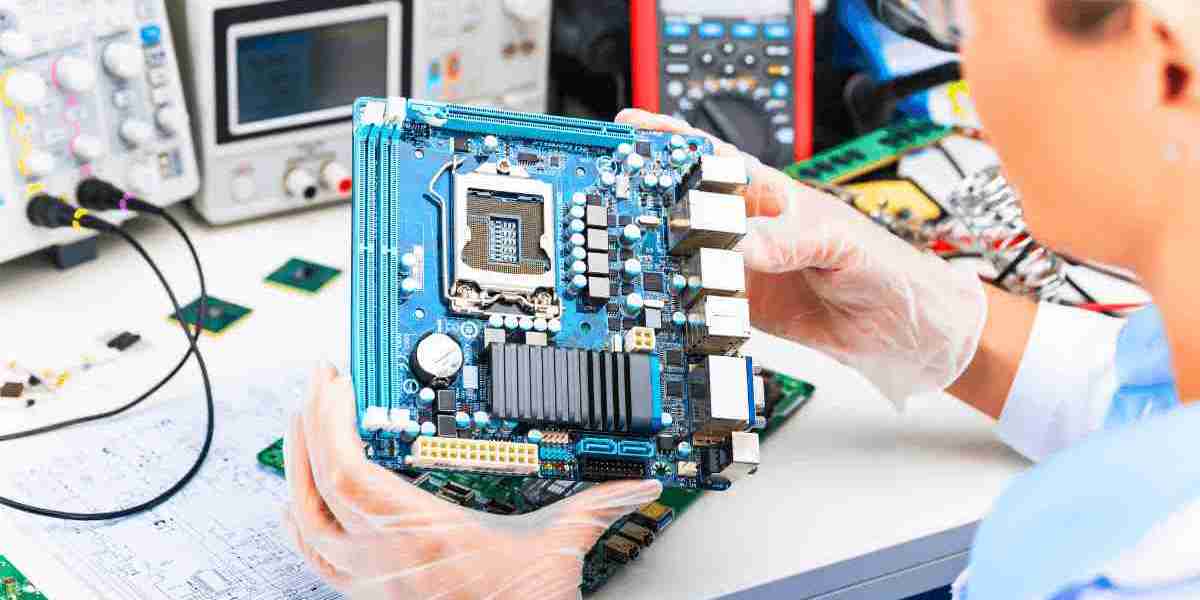In the fast-paced and highly competitive electronics manufacturing sector in Malaysia, ensuring worker safety is of paramount importance. The complex nature of the industry, with its intricate processes and exposure to various hazards, calls for effective safety measures to protect the well-being of workers.
This is where Health, Safety, and Environment (HSE) consulting comes into play. HSE consulting offers invaluable expertise and guidance to electronics manufacturers, helping them establish and maintain a safe working environment. By conducting thorough assessments, implementing best practices, and ensuring compliance with industry regulations, HSE consulting facilitates enhanced worker safety.
Electronics manufacturers in Malaysia face specific challenges and risks in their daily operations. These include exposure to hazardous materials, such as chemicals used in electronic components, as well as potential ergonomic issues due to repetitive tasks. HSE consulting assists in identifying and mitigating these risks through the implementation of comprehensive safety protocols and ergonomic workplace design.
The benefits of EHS consulting extend beyond worker safety alone. Compliance with occupational health and safety regulations is crucial to avoid legal liabilities and maintain a positive reputation within the industry. By partnering with experienced HSE consultants, electronics manufacturers can stay updated with relevant regulations and guidelines, ensuring adherence and reducing the risk of penalties or fines.
In addition, effective HSE consulting promotes overall business performance. By investing in a safer work environment, companies can experience improved productivity, higher employee morale, and decreased absenteeism due to work-related injuries. Moreover, businesses that prioritize worker safety are more likely to attract and retain skilled workers, contributing to their long-term success.
In the following sections, we will explore the key challenges and risks faced by the electronics manufacturing sector in Malaysia, delve into the intricacies of HSE consulting, and discuss the best practices that can be implemented to ensure worker safety and compliance with industry regulations.
Key Challenges and Risks in the Electronics Manufacturing Sector
The electronics manufacturing sector in Malaysia poses unique challenges and risks to the workers involved. It is important for industry players to address these challenges and mitigate the risks to ensure a safe and healthy work environment. Let's explore some of the key challenges and risks faced by workers in this sector.
Exposure to Hazardous Materials
One of the primary challenges in the electronics manufacturing sector is the exposure to hazardous materials. Workers come into contact with various chemicals and substances that can have detrimental effects on their health if not handled properly. These hazardous materials include solvents, fluxes, soldering fumes, and cleaning agents. Prolonged exposure to these substances can lead to respiratory issues, skin irritations, and even long-term health complications.
Repetitive Strain Injuries
Another common risk faced by workers in the electronics manufacturing industry is the development of repetitive strain injuries (RSIs). The nature of the work often involves repetitive movements, such as assembly line tasks and operating machinery. These repetitive actions can strain the muscles, tendons, and nerves, leading to conditions like carpal tunnel syndrome and tendonitis. Without proper ergonomics and preventive measures in place, workers are at a higher risk of developing these debilitating injuries.
Lack of Awareness and Training
A significant challenge in the electronics manufacturing sector is the lack of awareness and training among workers regarding occupational hazards and safety protocols. Many workers may not be fully aware of the potential risks associated with their job tasks or how to mitigate them effectively. Insufficient training programs and inadequate dissemination of safety information can contribute to accidents and injuries in the workplace.
High Pressure and Fast-Paced Environment
The electronics manufacturing sector is often characterized by a high-pressure and fast-paced work environment. Tight schedules, strict deadlines, and the need to meet production targets can create stressful conditions for workers. This increased stress level can impair focus, increase the likelihood of errors, and lead to accidents.
Language and Communication Barriers
The electronics manufacturing industry in Malaysia attracts a diverse workforce, including workers from different linguistic backgrounds. Language and communication barriers can pose challenges in effectively conveying important safety instructions and information. It is crucial to have clear and efficient communication channels in place to ensure that all workers understand safety protocols and can effectively communicate any concerns or issues.
Understanding HSE Consulting and Its Benefits
HSE consulting, which stands for Health, Safety, and Environment consulting, plays a crucial role in ensuring the well-being of employees in the electronics manufacturing sector in Malaysia. By implementing HSE consulting services, electronics manufacturers can create a safer work environment, ensure compliance with industry regulations and guidelines, and enhance overall business performance.
What is HSE Consulting?
HSE consulting involves engaging the expertise of professionals who specialize in occupational health and safety, risk management, and environmental sustainability. These consultants work closely with electronics manufacturers to identify potential hazards, assess risks, develop safety protocols, and implement best practices. They also help businesses navigate the complex landscape of industry regulations and ensure compliance.
Benefits of HSE Consulting in Electronics Manufacturing
1. Worker Safety: The primary objective of HSE consulting is to protect the well-being of employees. By conducting risk assessments and hazard identification processes, consultants can identify and address potential accidents, injuries, and illnesses. This leads to a safer work environment and a reduced number of workplace incidents.
2. Compliance with Regulations: The electronics manufacturing sector in Malaysia is subject to various occupational health and safety regulations and guidelines. HSE consultants assist manufacturers in understanding and complying with these requirements, ensuring that their operations meet the necessary standards and avoiding legal ramifications.
3. Improved Business Performance: Implementing HSE consulting practices not only benefits worker safety and regulatory compliance but also has a positive impact on business performance. By minimizing workplace incidents and injuries, companies can reduce downtime, increase productivity, and improve overall efficiency. Moreover, emphasizing worker well-being fosters a positive work culture that attracts and retains skilled employees.
4. Enhanced Reputation: Electronics manufacturers that prioritize worker safety and environmental sustainability through HSE consulting create a positive reputation in the industry. This can lead to improved customer trust, increased business opportunities, and better relationships with stakeholders.
Compliance with Occupational Health and Safety Regulations
Electronics manufacturers in Malaysia are subject to various occupational health and safety regulations and guidelines aimed at ensuring the well-being of their workers. Adhering to these regulations not only protects employees from potential hazards but also helps businesses maintain a safe and compliant working environment. Here are some key regulations that electronics manufacturers in Malaysia must follow:
Occupational Safety and Health Act (OSHA)
The Occupational Safety and Health Act (OSHA) is the primary legislation governing workplace safety in Malaysia. Under OSHA, employers are legally obligated to provide a safe and healthy working environment for their employees. This includes the implementation of safety policies, hazard assessments, and the provision of personal protective equipment (PPE) where necessary.
Factories and Machinery Act (FMA)
The Factories and Machinery Act (FMA) focuses specifically on factories and machinery-related hazards. It outlines requirements for safety measures in factories, such as machinery guarding, ventilation systems, and fire prevention measures. The FMA also mandates regular inspection and maintenance of machinery to ensure its safe operation.
Industry-Specific Regulations
In addition to the general regulations, there may be industry-specific guidelines that electronics manufacturers must comply with. For example, if a manufacturing facility handles chemical substances, they must adhere to the Chemical Management Regulations that govern the safe handling, storage, and disposal of hazardous chemicals.
International Standards
Electronics manufacturers often strive to meet international standards, such as ISO 45001 Occupational Health and Safety Management System. By implementing these standards, businesses demonstrate their commitment to providing a safe and healthy workplace while also enhancing their reputation in the global market.
To ensure compliance with these regulations and guidelines, electronics manufacturers need to establish robust health and safety management systems. This includes regular inspections, risk assessments, employee training programs, and a culture of safety awareness.
By prioritizing compliance with occupational health and safety regulations, electronics manufacturers in Malaysia can protect their workers, reduce the risk of accidents and injuries, and create a positive work environment that promotes overall business success.
Risk Assessment and Hazard Identification
In the electronics manufacturing sector, conducting thorough risk assessments and hazard identification processes is crucial for ensuring the safety and well-being of workers. This proactive approach allows companies to identify potential risks and hazards in the workplace, and implement appropriate control measures to mitigate them.
One of the main objectives of risk assessments is to identify the hazards that workers may be exposed to during their daily operations. This includes physical hazards such as electrical shocks, fire hazards, and chemical exposures. Additionally, ergonomic hazards like repetitive strain injuries and musculoskeletal disorders can also be identified through these assessments.
By analyzing the potential risks and hazards, companies can prioritize their efforts to minimize the likelihood of accidents and injuries. This includes implementing engineering controls, such as improving ventilation systems to reduce the exposure to harmful substances, and utilizing ergonomic workstations to prevent injuries caused by repetitive tasks.
Moreover, risk assessments enable companies to comply with occupational health and safety regulations, as well as industry guidelines. These assessments help organizations to identify gaps in their safety protocols and make necessary improvements to ensure compliance with the relevant regulations.
To conduct a thorough risk assessment, it is important to involve employees at all levels of the organization. They often have valuable insights into daily operations and can provide valuable input on potential hazards. Engaging workers in this process not only fosters a culture of safety but also helps in identifying hazards that might otherwise be overlooked.
Implementing Safety Protocols and Best Practices
Ensuring worker safety in the electronics manufacturing sector in Malaysia requires the implementation of effective safety protocols and best practices. By following specific guidelines and practices, electronics manufacturers can create a safer work environment and reduce the risk of accidents and injuries. Here are some key safety protocols and best practices that can be implemented:
Proper Handling of Hazardous Substances
- Develop clear procedures for the storage, handling, and disposal of hazardous substances in accordance with occupational health and safety regulations.
- Train employees on proper handling techniques, including the use of personal protective equipment (PPE), such as gloves, goggles, and masks.
- Regularly conduct chemical risk assessments to identify potential hazards and implement appropriate control measures.
Ergonomic Workplace Design
- Design workstations and production lines ergonomically to reduce the risk of musculoskeletal disorders and repetitive strain injuries.
- Provide adjustable workstations, chairs, and equipment to accommodate different body types and promote proper posture.
- Encourage frequent breaks and stretching exercises to relieve muscle tension and promote employee well-being.
Machine Guarding and Lockout-Tagout Procedures
- Install safety guards on machinery to prevent accidental contact with moving parts.
- Implement lockout-tagout procedures to ensure that machines are properly shut down and de-energized before maintenance or repair work.
- Train employees on lockout-tagout procedures and provide clear instructions for safe equipment shutdown and startup.
Fire Safety Measures
- Install and regularly maintain fire detection and suppression systems, including fire alarms, sprinkler systems, and fire extinguishers.
- Conduct regular fire drills to familiarize employees with evacuation procedures and emergency exits.
- Designate fire assembly points and ensure clear signage to facilitate efficient evacuation in the event of a fire.
Personal Protective Equipment (PPE)
- Provide appropriate personal protective equipment to employees based on job-specific hazards and risks.
- Regularly inspect and maintain PPE to ensure its effectiveness.
- Train employees on the correct use and care of PPE and enforce its usage in relevant work areas.
Safety Inspections and Audits
- Conduct regular safety inspections to identify potential hazards and areas for improvement.
- Establish a process for reporting and addressing safety concerns or near-miss incidents.
- Implement a robust audit program to ensure ongoing compliance with safety protocols and best practices.
By implementing these safety protocols and best practices, electronics manufacturers in Malaysia can create a safer work environment and protect the well-being of their employees. It is important to regularly review and update these practices to address emerging risks and ensure continuous improvement in safety standards. Remember, a strong focus on worker safety not only reduces the risk of accidents and injuries but also improves overall business performance and maintains regulatory compliance.
Emergency Preparedness and Response
Ensuring effective emergency preparedness and response plans is crucial in the electronics manufacturing sector in Malaysia. With the potential for workplace incidents, including fires, hazardous material spills, and accidents, companies must prioritize the safety and well-being of their employees. This section will highlight the importance of having comprehensive emergency plans in place, including evacuation procedures, fire safety measures, and appropriate responses to workplace incidents.
Evacuation Procedures
Implementing clear and well-communicated evacuation procedures is essential for employee safety. In the event of an emergency, workers need to know where to go and how to exit the building safely. This includes designated evacuation routes, assembly points, and instructions on how to assist individuals with mobility challenges. Regular drills and training sessions should be conducted to ensure everyone is familiar with the evacuation protocols.
Fire Safety Measures
Electronics manufacturing involves various flammable materials, making fire safety measures paramount. Companies should invest in fire detection and suppression systems, such as smoke alarms, sprinkler systems, and fire extinguishers. Regular maintenance and inspections should be carried out to ensure these systems are fully functional. Additionally, employees should be educated on fire prevention practices, the use of fire-fighting equipment, and the importance of reporting potential fire hazards promptly.
Response to Workplace Incidents
Quick and efficient response to workplace incidents can significantly minimize their impact. Clear communication channels and reporting mechanisms should be established to promptly address incidents and hazards. Designated first-aid responders or medical personnel should be trained to provide immediate assistance to injured employees. Having well-equipped first-aid kits readily available throughout the facility is also crucial.
Ensuring Continuous Improvement and Compliance Monitoring
Continuous improvement and compliance monitoring are crucial for maintaining a safe and compliant workplace in the electronics manufacturing sector. By consistently evaluating safety practices and implementing improvement initiatives, companies can proactively identify and address potential risks, ensuring the well-being of their workers.
Ongoing Monitoring of Safety Practices
Regular monitoring of safety practices allows electronics manufacturers to identify any gaps or issues that may compromise worker safety. This involves conducting regular inspections, audits, and assessments to ensure compliance with occupational health and safety regulations and industry guidelines. By monitoring safety protocols, companies can quickly identify and rectify any deficiencies, reducing the likelihood of accidents or injuries.
Evaluation and Analysis
In addition to monitoring, ongoing evaluation and analysis play a vital role in maintaining safety standards. This entails collecting data and analyzing it to identify trends, patterns, and areas for improvement. By studying incident reports, near misses, and employee feedback, companies can gain valuable insights into potential risks and make informed decisions to enhance safety protocols.
Continuous Improvement Initiatives
Once areas for improvement have been identified, electronics manufacturers can implement continuous improvement initiatives to address them effectively. This may involve revising safety policies, enhancing training programs, or investing in new technologies or equipment that promote a safer work environment.
Compliance Monitoring
Compliance monitoring ensures that all safety practices and protocols align with occupational health and safety regulations. This involves regular review of policies, procedures, and guidelines to confirm adherence to legal requirements. By conducting thorough compliance checks, electronics manufacturers can safeguard against potential penalties and legal liabilities.
Reporting and Documentation
Documentation of safety practices, incidents, and improvement initiatives is essential for compliance monitoring. Accurate and thorough records allow companies to track progress, demonstrate due diligence, and provide evidence of compliance with regulations.
Conclusion
The implementation of HSE consulting services in the electronics manufacturing sector in Malaysia is crucial for ensuring worker safety and creating a healthier work environment. By adhering to occupational health and safety regulations, conducting thorough risk assessments, and identifying workplace hazards, electronics manufacturers can effectively mitigate key challenges and risks faced by their workers.
The benefits of HSE consulting go beyond compliance. It helps businesses enhance overall business performance by reducing workplace incidents, minimizing injuries, and improving worker well-being. Implementing safety protocols and best practices, such as proper handling of hazardous substances and ergonomic workplace design, plays a vital role in creating a safer working environment.
Overall, HSE consulting is an indispensable aspect of the electronics manufacturing industry in Malaysia. It not only protects workers but also drives business success by fostering a safe and productive work environment.








